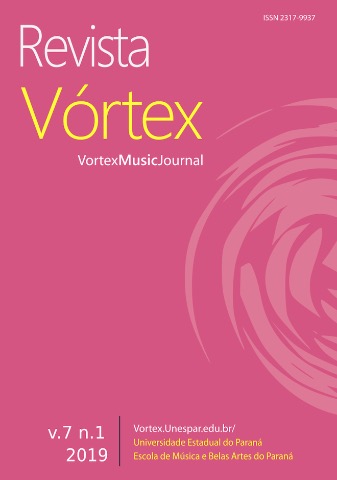'Em todas as coisas a mudança é doce': Varietas e paixão na música italiana renascentista
DOI:
https://doi.org/10.33871/23179937.2019.7.1.2681Resumo
Neste estudo investigamos a procura ocorrida durante a Renascença por uma música emocionalmente envolvente. Por meio do estudo dos redescobertos tratados de retórica da Antiguidade, os teóricos da música na Itália reforçam a ligação entre música e poesia e aplicam a máxima de Platão de que a música deve servir ao texto. Mediante estudos de fontes primárias – Tinctoris, Ganassi, Vicentino, Zarlino e Alberti – e secundárias sobre teóricos como Cícero e Quintiliano, elementos da retórica, principalmente decorum e pronuntiatio, são abordados para dar suporte à hipótese de que o conceito retórico de varietas foi usado como meio para criar expressividade musical.Downloads
Referências
ALBERTI, Leon Battista. De pictura. Bari: Laterza, 1998. E-book. ISBN: 9788897313502. Disponível em: http://www.liberliber.it/online/opere/libri/licenze. Acesso em: 26.05.2017.
BARTEL, Dietrich. Musica Poetica – Musical-Rhetorical Figures in German Baroque Music. Lincoln: University of Nebraska Press, 1997.
BORGERDING, Todd. Preachers, 'Pronunciatio', and Music. Hearing Rhetoric in Renaissance Sacred Polyphony. The Musical Quarterly, vol. 82, no. 3/4, edição especial: "Music as Heard" (outono-inverno), p. 586-598, 1998.
BOYDEN, David D. The History of Violin Playing from its Origins to 1761 and its Relationship to the Violin and Violin Music. New York: Oxford University Press, 1990.
ENDERS, Jody. Music, Delivery, and the Rhetoric of Memory in Guillaume de Machaut's Remède de Fortune. PMLA, vol. 107, no. 3, Special Topic: Performance, p. 450-464, maio, 1992.
FABIAN, D.; TIMMERS, R.; SCHUBERT, E. (Ed.). Expressiveness in Music Performance – Empirical Approaches across Styles and Cultures. New York: Oxford University Press, 2014.
FANTHAM, Elaine. Varietas and Satietas; De oratore 3.96–103 and the limits of ornatus. A Journal of the History of Rhetoric, vol. 6, no. 3, p. 275-290, Summer, 1988.
FARANDA, Rino; PECCHIURA, Piero (Ed.). Marco Fabio Quintiliano. L'istituzione oratoria, volume secondo. Torino: Unione tipografico-editrice Torinese, 2003, p. 274+276.
FELDMAN, Martha. The Composer as Exegete: Interpretations of Petrarchan Syntax in the Venetian Madrigal. In: GALLAGHER, Sean (Ed.). Secular Renaissance Music. Forms and Functions. New York: Routledge, 2016, p. 611-646.
GALILEI, Vincenzo. Dialogo della musica antica, et della moderna, Florença, 1581.
GALLO, F. Alberto. Pronuntiatio. Ricerche sulla storia di un termine retorico-musicale. Acta Musicologica, vol. 35, fasc. 1, p. 38-46, Jan.-Mar., 1963.
GANASSI, Sylvestro. Regola Rubertina, Veneza, 1542.
HALLAM, S.; CROSS, I.; THAUT, M. (Ed.). The Oxford Handbook of Music Psychology. New York: Oxford University Press, 2016.
HARRíN, Don. Toward a Rhetorical Code of Early Music Performance. The Journal of Musicology, vol. 15, no. 1, p. 19-42, Winter, 1997.
_____. Elegance as a Concept in Sixteenth-Century Music Criticism. Renaissance Quarterly, vol. 41, no. 3, p. 413-438, Autumn, 1988.
HAYNES, Bruce; BURGESS, Geoffrey. The Pathetick Musician. Moving an Audience in the Age of Eloquence. New York: Oxford University Press, 2016.
JAMBE DE FER, Philibert. Epitome musical, Lyon, 1556.
KIRKENDALE, Warren. Ciceronians versus Aristotelians on the Ricercar as Exordium, from Bembo to Bach. Journal of the American Musicological Society, vol. 32, No. 1, primavera, p. 1-44, 1979.
LAUSBERG, Heinrich. Elemente der literarischen Rhetorik. Eine Einführung für Studierende der klassischen, romanischen, englischen und deutschen Philologie. Ismaning: Max Hueber Verlag, 1990.
LOWINSKY, Edward E. Music of the Renaissance as Viewed by Renaissance Musicians. In: O'KELLY, Bernard (Ed.). The Renaissance Image of Man and The World. Columbus: Ohio State University Press, p. 129-177, 1966.
LUKO, Alexis. Tinctoris on Varietas. Early Music History, vol. 27, pp. 99-136, 2008.
McCRELESS, Patrick. Music and Rhetoric. In: CHRISTENSEN, Thomas (Ed.). The Cambridge History of Western Music Theory. Cambridge: Cambridge University Press, 2002.
NORCIO, Giuseppe (Ed.). Opere retoriche di M. Tullio Cicerone, volume primo. De Oratore, Brutus, Orator. Torino: Unione tipografico-editrice Torinese, 1970.
OLSON, S. Douglas (Ed.). Ancient Comedy and Reception. Essays in Honor of Jeffrey Henderson. Berlin/Boston: Walter de Gruyter GmbH, 2014.
PALISCA, Claude V. Music and Ideas in the Sixteenth and the Seventeenth Century. Urbana and Chicago: University of Illinois Press, 2006.
SMITH, Anne. The Performance of 16th-Century Music. Learning from the Theorists. New York: Oxford University Press. Edição do Kindle, 2011.
TARLING, Judith. The Weapons of Rhetoric. A Guide for Musicians and Audiences. Hertfordshire: Corda Music Publications, 2004.
VICENTINO, Nicola. L'Antica musica ridotta alla moderna prattica, Roma, 1555.
WEGMAN, Rob C. Sense and Sensibility in Late-Medieval Music: Thoughts on Aesthetics and 'Authenticity'. Early Music, vol. 23, no. 2, p. 298-304+306-308+310-312, May 1995.
WILSON, Blake McDowell. Ut oratoria musica in the Writings of Renaissance Music Theory. In: MATHIESEN, Thomas. J.; RIVERA, Benito V. (Ed.). Festa Musicologica. Essays in Honor of George J. Buelow. Stuyvesant: Pendragon Press, 1995.
ZARLINO, Gioseffo. Sopplimenti musicali, Veneza, 1588.
Downloads
Publicado
Como Citar
Edição
Seção
Licença
Copyright (c) 2021 Atli Ellendersen

Este trabalho está licenciado sob uma licença Creative Commons Attribution 4.0 International License.
Autores mantêm os direitos autorais e concedem à revista o direito de primeira publicação, com o trabalho simultaneamente licenciado sob a Licença Creative Commons Attribution que permite o compartilhamento do trabalho com reconhecimento da autoria e publicação inicial nesta revista.






